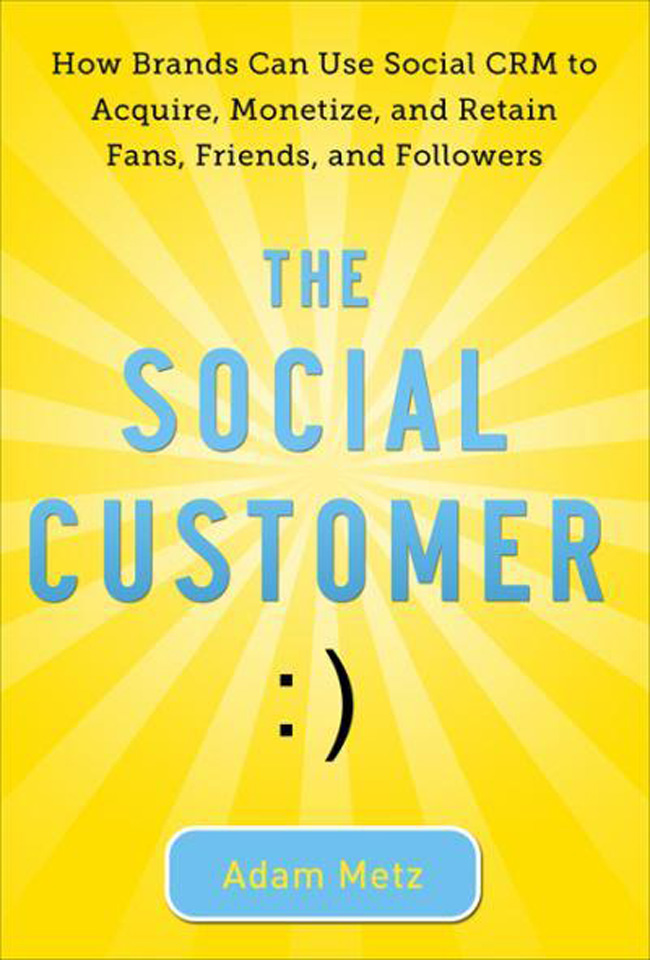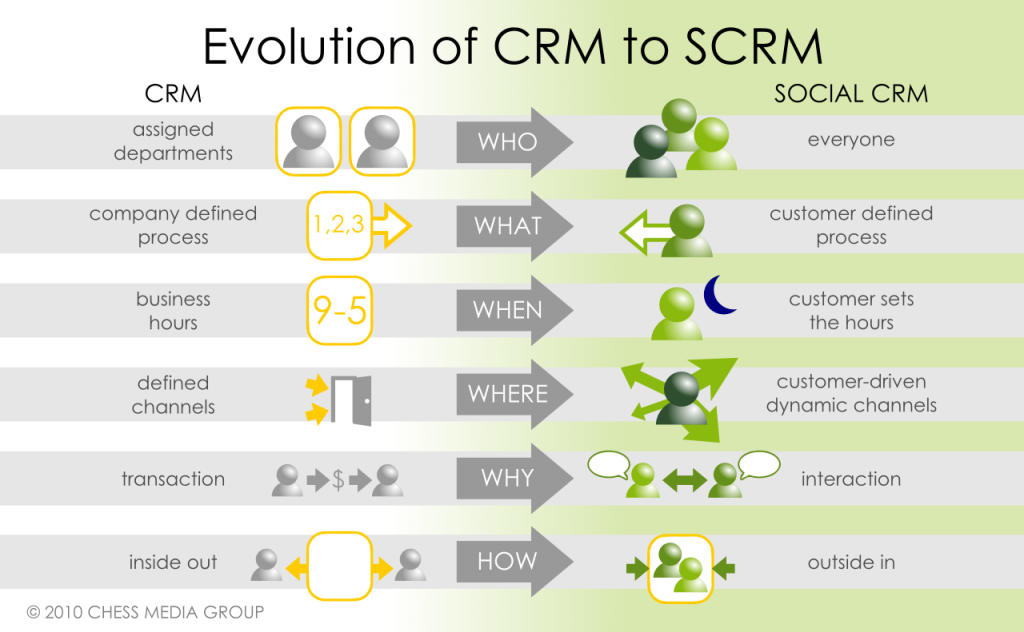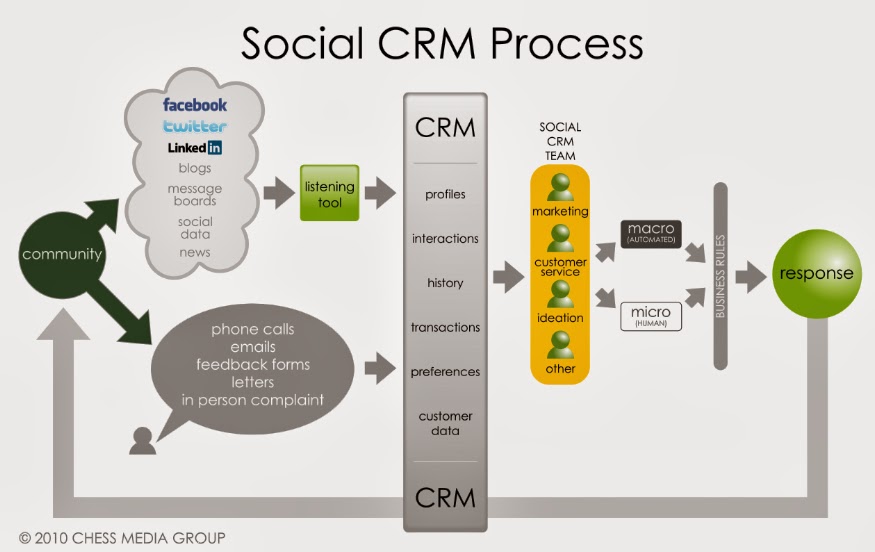Courtesy of Simplify 360
The greatest challenge of the social media age isn’t to grow the largest fan or follower base. Nor to achieve the greatest “virality” in our digital campaigns.
Rather, it is this:
“How can we better reach prospects, convert them to customers, and serve their interests through social media?”While Facebook, Twitter and YouTube have found ways to monetise their platforms, many are still figuring out ways to connect one’s communities on social media with the corporate wallet.
Enter The Social Customer by Adam Metz.
Covering a wide range of topics on social Customer Relationship Management (CRM), this ambitious book spans a wide spectrum of social business topics. They range from social customer insights, marketing, sales, analytics, demand management, support, and customer experience, to mobile and location based services.
Defining Social CRM
First, we need to understand what Social CRM is. Metz provides a good definition in his book as follows:
“The customer owns the conversation now, so companies need to change the way they do business. Social CRM is a philosophy and a business strategy that uses technology, work flow, business rules, and social information to talk with (not at) the customer in a transparent way, to make value for both parties.”
This philosophy of designing processes, workflows and experiences around the customer rather than the company is the key pillar of Social CRM (SCRM).
Unlike traditional CRM, Social CRM (or SCRM) is about how companies reach out to customers at the times and channels where the customer feels most at ease. In other words, a company is viewed more as a peer rather than an institution.
This can be perceived through the chart below:
Courtesy of The Future Organization
In order to make company brands “social objects” (stuff which people want to talk about), companies can consider the six foundational premises of Social CRM articulated by Paul Greenberg. These revolve around the following principles:
- Companies should make themselves likable and relatable to customers;
- Companies should help customers control their lives;
- Companies should help customers fulfill their agendas;
- Companies should be non-obtrusive and un-interrupting;
- Companies should provide value to the customers; and
- Companies should provide delightful and memorable experiences to customers.
The Social CRM Process
According to Metz, the Social CRM process is fairly involved. It covers community management, listening on social channels, mining of one’s customer database, establishment of a social CRM team, and the invoking of either macro responses (automated activities like birthday coupons) or micro responses (manual interventions like organising a press briefing).
These activities can be visualised by Chess Media’s chart below:
Courtesy of Chess Media Group
23 ways to use Social CRM
From the basics, Metz goes on to describe the 23 Use Cases of Social CRM.
Covering social customer insights, marketing, sales, service/support, innovation, collaboration, and customer experience, the use cases illustrates examples of companies doing them, market and technology maturity levels, and recommended vendors.
These use cases straddle what Metz calls the 5 Ms in social customer insights. They are namely: monitoring, mapping, middleware, management and measurement.
You can see how these concepts are categorised in the chart by Altimeter Group and Metz Consulting below:

Courtesy of The Social Concept
Social CRM Methodology
From the Use Cases, the book proposes that a Social CRM methodology could be adopted. Represented by the acronym lPOSTm, the steps involved are…
- l = Listening to what your customers are saying
- P = People and your relationships with them
- O = Objectives, ie what your brand wants to do
- S = Strategy, the stuff that the book teaches
- T = Tools, the myriad platforms and software needed
- m = Measurement, a necessary evil
Bringing Social CRM Strategy alive
To make one’s social CRM strategy come alive, the book proposes the following key actions:
#1 Develop a Strategy Canvas
Adopt a strategy canvas approach (ala Blue Ocean Strategy) to differentiate your business from the “red oceans” of competitors.
Here you should consider the Four Actions Framework, namely to eliminate factors your industry take for granted, raise factors of social customer management above industry norms, reduce areas that are less valuable to social customers, and create new factors of value.
#2 Differentiate Social CRM from its components
Avoid confusing Social CRM with its disparate components like database marketing, IT systems, loyalty programmes, social media platforms, or marketing and PR alone. This is important in order to integrate these other activities in a way that brings value to the customer.
#3 Measure Social CRM holistically
Create a holistic way of measuring your Social CRM activities through dashboards monitoring KPIs such as the following:
- Net Promoter Scores – how likely are your customers to recommend you to others?
- Brand Reputation – usually provided by social sentiment firms, they monitor online brand perceptions
- Social Collateral Engagement – online “buzz” like conversation levels, influence of commenters, sentiment of comments, and qualitative feedback
- Social Ecosystem Health – number of online community members, types of content shared, visitor traffic, interactions, and responses
- Social Commerce – actual conversation to sales, customer reach and group marketing efforts, often by affiliates
#4 Craft detailed workflows and pathways
Put together fairly detailed workflows and escalation paths. These require integrating Social CRM systems with both customer and non-customer facing processes such as the following:
- Customer service processes – eg call centre, conflict resolutions, technical support
- Enterprise Resource Planning (ERP)
- Supply Chain Management (SCM)
The goal here is to provide integrated and seamless customer-support across all touch-points, from reach, acquisition, conversion, to after-sales customer service, customer loyalty to customer advocacy.
#5 Integrate with social advertising and technologies
Embrace and integrate social CRM with social advertising and retail as well as the emerging opportunities offered by mobile apps and geo-location technologies. This should ensure that there is coherence in how the company views the customer across the entire spectrum of customer touch-points.
A Useful Guide to Social Media with CRM
In a nutshell, The Social Customer provides a comprehensive guide to the emerging world of social CRM, social commerce and customer experience management.
As an introduction to the wide ranging topics, it doesn’t delve deeply into each individual arena. At times, I found it challenging to visualise how the various multiple systems look like and had to stop to think hard to imagine how A connected to B and C.
Having said that, Metz does provide lots of useful links and references throughout the volume. He is also generous in giving credit to many of his contemporaries while citing and modifying their ideas.
Overall, the book is a useful guide to companies keen to incorporate CRM approaches to their social media channels.





Nice post meh, I learnt something from this post and I’m working on making it useful. The blog reminds me of an equally interesting blog on my reading list http://danieluyi.com Dating and Personal Development Blog .
keep up the good work.
Regards
Wonderful site and I wanted to post a note to let you know, “”Good job””! I’m glad I found this blog. Brilliant and wonderful job! Your blog site has presented me most of the strategies which I like. Thanks for sharing this.
Advertising agency in UK
What a thought-provoking post! The evolution of social CRM underscores the significance of engaging customers where they have the loudest voice – in this era, that’s within the digital sphere. AI tools are revolutionizing this process, offering a scalable way to personalize interactions and deepen customer relationships. Platforms like VoiceSphere are at the forefront, facilitating interactive document conversations through a user-friendly chat interface. Their innovative approach can be seen at voicesphere.co, serving as an excellent case study worth exploring further. AI-driven interaction platforms could well be the next frontier in building social businesses and enhancing customer experiences.